HSH 703: Alcohol Interventions & Health Promotion for Young People
VerifiedAdded on 2023/06/11
|18
|4750
|497
Report
AI Summary
This report examines the issue of alcohol addiction among young people in Southern Grampians and Glenelg, where rates exceed the national average, leading to assaults, injuries, and negative impacts on physical and mental health, including academic performance. It employs a socio-ecological determinants approach, considering individual, environmental, and socio-economic factors influencing alcohol consumption. The report details health promotion interventions, mapping them against the Ottawa Charter, emphasizing community action, skill development, supportive environments, reorientation of health services, and public policy. It addresses improving daily life conditions, tackling inequalities in resource distribution, and outlines measurement and action plans. The report further discusses the political and social determinants of health, advocating for progressive politics, affordable health services, and equal resource distribution to combat alcohol-related harm among young people.
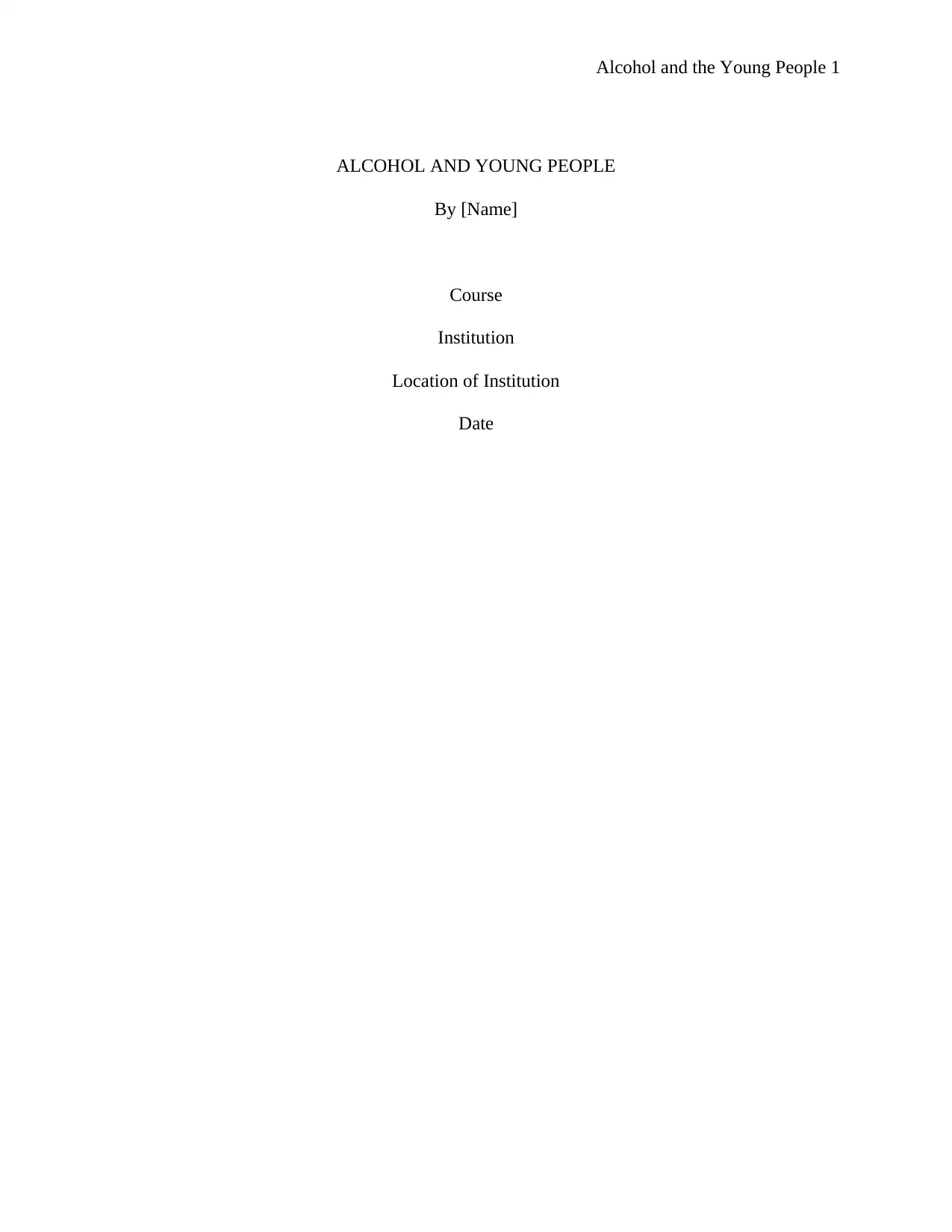
Alcohol and the Young People 1
ALCOHOL AND YOUNG PEOPLE
By [Name]
Course
Institution
Location of Institution
Date
ALCOHOL AND YOUNG PEOPLE
By [Name]
Course
Institution
Location of Institution
Date
Paraphrase This Document
Need a fresh take? Get an instant paraphrase of this document with our AI Paraphraser
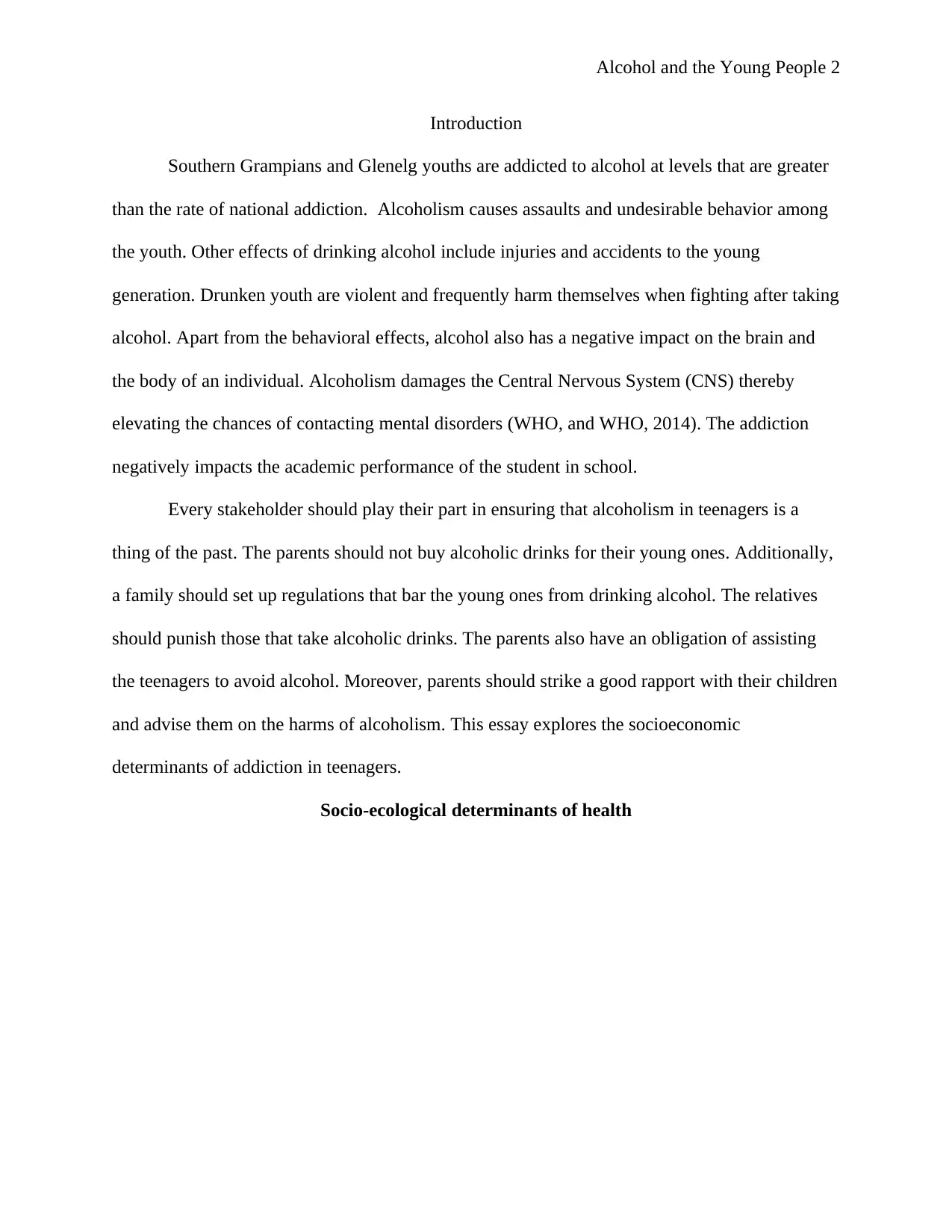
Alcohol and the Young People 2
Introduction
Southern Grampians and Glenelg youths are addicted to alcohol at levels that are greater
than the rate of national addiction. Alcoholism causes assaults and undesirable behavior among
the youth. Other effects of drinking alcohol include injuries and accidents to the young
generation. Drunken youth are violent and frequently harm themselves when fighting after taking
alcohol. Apart from the behavioral effects, alcohol also has a negative impact on the brain and
the body of an individual. Alcoholism damages the Central Nervous System (CNS) thereby
elevating the chances of contacting mental disorders (WHO, and WHO, 2014). The addiction
negatively impacts the academic performance of the student in school.
Every stakeholder should play their part in ensuring that alcoholism in teenagers is a
thing of the past. The parents should not buy alcoholic drinks for their young ones. Additionally,
a family should set up regulations that bar the young ones from drinking alcohol. The relatives
should punish those that take alcoholic drinks. The parents also have an obligation of assisting
the teenagers to avoid alcohol. Moreover, parents should strike a good rapport with their children
and advise them on the harms of alcoholism. This essay explores the socioeconomic
determinants of addiction in teenagers.
Socio-ecological determinants of health
Introduction
Southern Grampians and Glenelg youths are addicted to alcohol at levels that are greater
than the rate of national addiction. Alcoholism causes assaults and undesirable behavior among
the youth. Other effects of drinking alcohol include injuries and accidents to the young
generation. Drunken youth are violent and frequently harm themselves when fighting after taking
alcohol. Apart from the behavioral effects, alcohol also has a negative impact on the brain and
the body of an individual. Alcoholism damages the Central Nervous System (CNS) thereby
elevating the chances of contacting mental disorders (WHO, and WHO, 2014). The addiction
negatively impacts the academic performance of the student in school.
Every stakeholder should play their part in ensuring that alcoholism in teenagers is a
thing of the past. The parents should not buy alcoholic drinks for their young ones. Additionally,
a family should set up regulations that bar the young ones from drinking alcohol. The relatives
should punish those that take alcoholic drinks. The parents also have an obligation of assisting
the teenagers to avoid alcohol. Moreover, parents should strike a good rapport with their children
and advise them on the harms of alcoholism. This essay explores the socioeconomic
determinants of addiction in teenagers.
Socio-ecological determinants of health
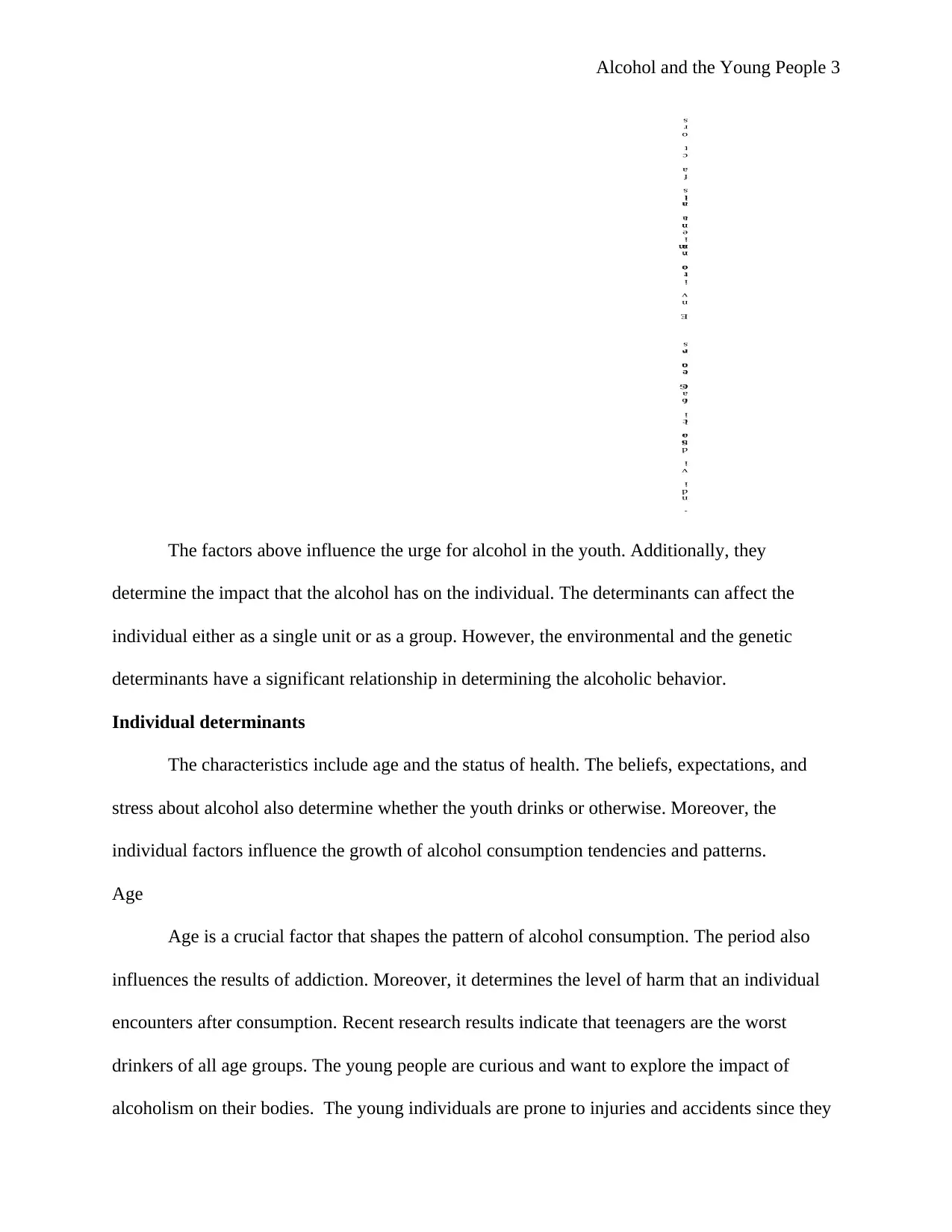
Alcohol and the Young People 3
The factors above influence the urge for alcohol in the youth. Additionally, they
determine the impact that the alcohol has on the individual. The determinants can affect the
individual either as a single unit or as a group. However, the environmental and the genetic
determinants have a significant relationship in determining the alcoholic behavior.
Individual determinants
The characteristics include age and the status of health. The beliefs, expectations, and
stress about alcohol also determine whether the youth drinks or otherwise. Moreover, the
individual factors influence the growth of alcohol consumption tendencies and patterns.
Age
Age is a crucial factor that shapes the pattern of alcohol consumption. The period also
influences the results of addiction. Moreover, it determines the level of harm that an individual
encounters after consumption. Recent research results indicate that teenagers are the worst
drinkers of all age groups. The young people are curious and want to explore the impact of
alcoholism on their bodies. The young individuals are prone to injuries and accidents since they
G
e
n
e
t
i
c
F
a
c
t
o
r
s
S
o
c
i
o
e
c
o
n
o
m
i
c
d
e
t
e
r
m
i
n
a
n
t
s
I
n
d
i
v
i
d
u
a
l
f
a
c
t
o
r
s
E
n
v
i
r
o
n
m
e
n
t
a
l
f
a
c
t
o
r
s
The factors above influence the urge for alcohol in the youth. Additionally, they
determine the impact that the alcohol has on the individual. The determinants can affect the
individual either as a single unit or as a group. However, the environmental and the genetic
determinants have a significant relationship in determining the alcoholic behavior.
Individual determinants
The characteristics include age and the status of health. The beliefs, expectations, and
stress about alcohol also determine whether the youth drinks or otherwise. Moreover, the
individual factors influence the growth of alcohol consumption tendencies and patterns.
Age
Age is a crucial factor that shapes the pattern of alcohol consumption. The period also
influences the results of addiction. Moreover, it determines the level of harm that an individual
encounters after consumption. Recent research results indicate that teenagers are the worst
drinkers of all age groups. The young people are curious and want to explore the impact of
alcoholism on their bodies. The young individuals are prone to injuries and accidents since they
G
e
n
e
t
i
c
F
a
c
t
o
r
s
S
o
c
i
o
e
c
o
n
o
m
i
c
d
e
t
e
r
m
i
n
a
n
t
s
I
n
d
i
v
i
d
u
a
l
f
a
c
t
o
r
s
E
n
v
i
r
o
n
m
e
n
t
a
l
f
a
c
t
o
r
s
⊘ This is a preview!⊘
Do you want full access?
Subscribe today to unlock all pages.

Trusted by 1+ million students worldwide
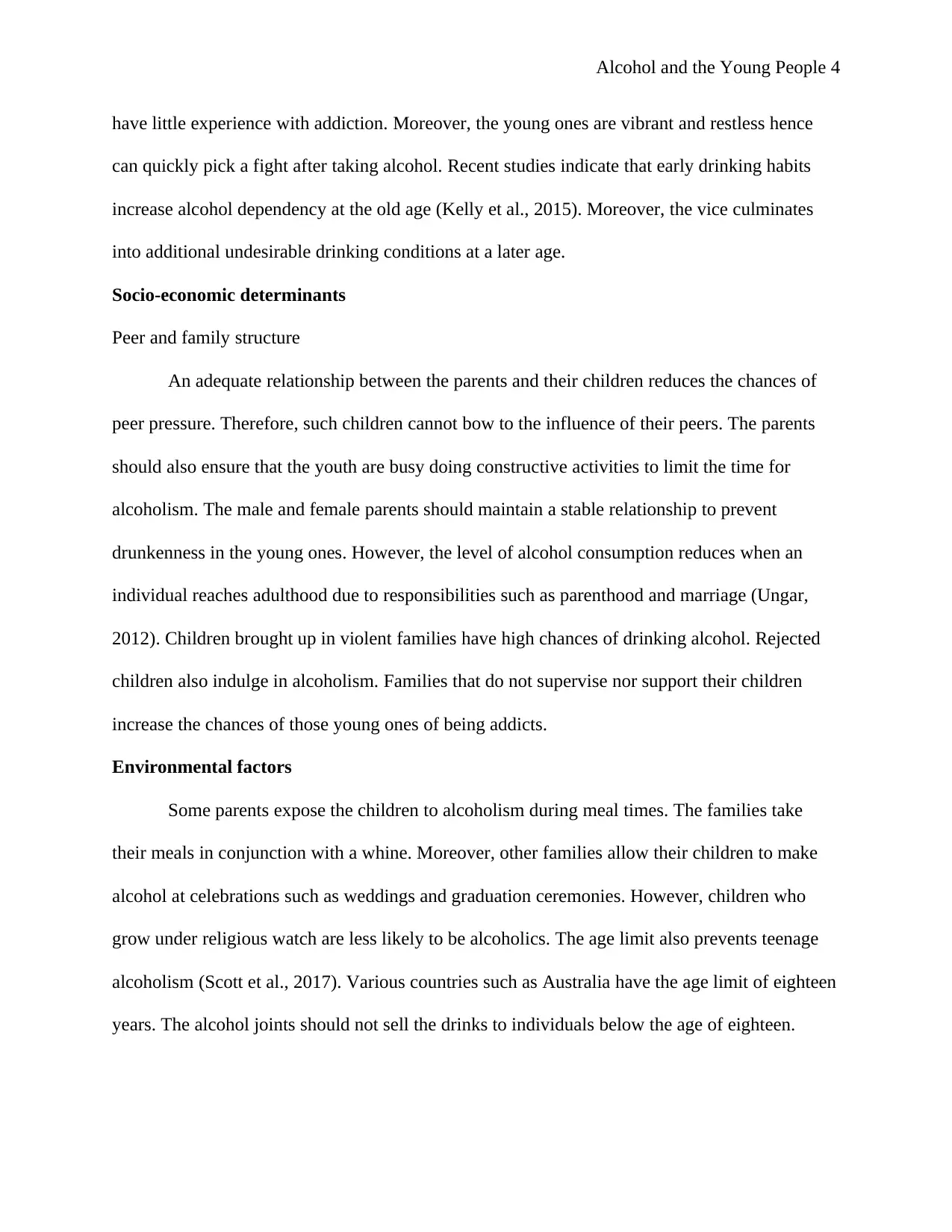
Alcohol and the Young People 4
have little experience with addiction. Moreover, the young ones are vibrant and restless hence
can quickly pick a fight after taking alcohol. Recent studies indicate that early drinking habits
increase alcohol dependency at the old age (Kelly et al., 2015). Moreover, the vice culminates
into additional undesirable drinking conditions at a later age.
Socio-economic determinants
Peer and family structure
An adequate relationship between the parents and their children reduces the chances of
peer pressure. Therefore, such children cannot bow to the influence of their peers. The parents
should also ensure that the youth are busy doing constructive activities to limit the time for
alcoholism. The male and female parents should maintain a stable relationship to prevent
drunkenness in the young ones. However, the level of alcohol consumption reduces when an
individual reaches adulthood due to responsibilities such as parenthood and marriage (Ungar,
2012). Children brought up in violent families have high chances of drinking alcohol. Rejected
children also indulge in alcoholism. Families that do not supervise nor support their children
increase the chances of those young ones of being addicts.
Environmental factors
Some parents expose the children to alcoholism during meal times. The families take
their meals in conjunction with a whine. Moreover, other families allow their children to make
alcohol at celebrations such as weddings and graduation ceremonies. However, children who
grow under religious watch are less likely to be alcoholics. The age limit also prevents teenage
alcoholism (Scott et al., 2017). Various countries such as Australia have the age limit of eighteen
years. The alcohol joints should not sell the drinks to individuals below the age of eighteen.
have little experience with addiction. Moreover, the young ones are vibrant and restless hence
can quickly pick a fight after taking alcohol. Recent studies indicate that early drinking habits
increase alcohol dependency at the old age (Kelly et al., 2015). Moreover, the vice culminates
into additional undesirable drinking conditions at a later age.
Socio-economic determinants
Peer and family structure
An adequate relationship between the parents and their children reduces the chances of
peer pressure. Therefore, such children cannot bow to the influence of their peers. The parents
should also ensure that the youth are busy doing constructive activities to limit the time for
alcoholism. The male and female parents should maintain a stable relationship to prevent
drunkenness in the young ones. However, the level of alcohol consumption reduces when an
individual reaches adulthood due to responsibilities such as parenthood and marriage (Ungar,
2012). Children brought up in violent families have high chances of drinking alcohol. Rejected
children also indulge in alcoholism. Families that do not supervise nor support their children
increase the chances of those young ones of being addicts.
Environmental factors
Some parents expose the children to alcoholism during meal times. The families take
their meals in conjunction with a whine. Moreover, other families allow their children to make
alcohol at celebrations such as weddings and graduation ceremonies. However, children who
grow under religious watch are less likely to be alcoholics. The age limit also prevents teenage
alcoholism (Scott et al., 2017). Various countries such as Australia have the age limit of eighteen
years. The alcohol joints should not sell the drinks to individuals below the age of eighteen.
Paraphrase This Document
Need a fresh take? Get an instant paraphrase of this document with our AI Paraphraser
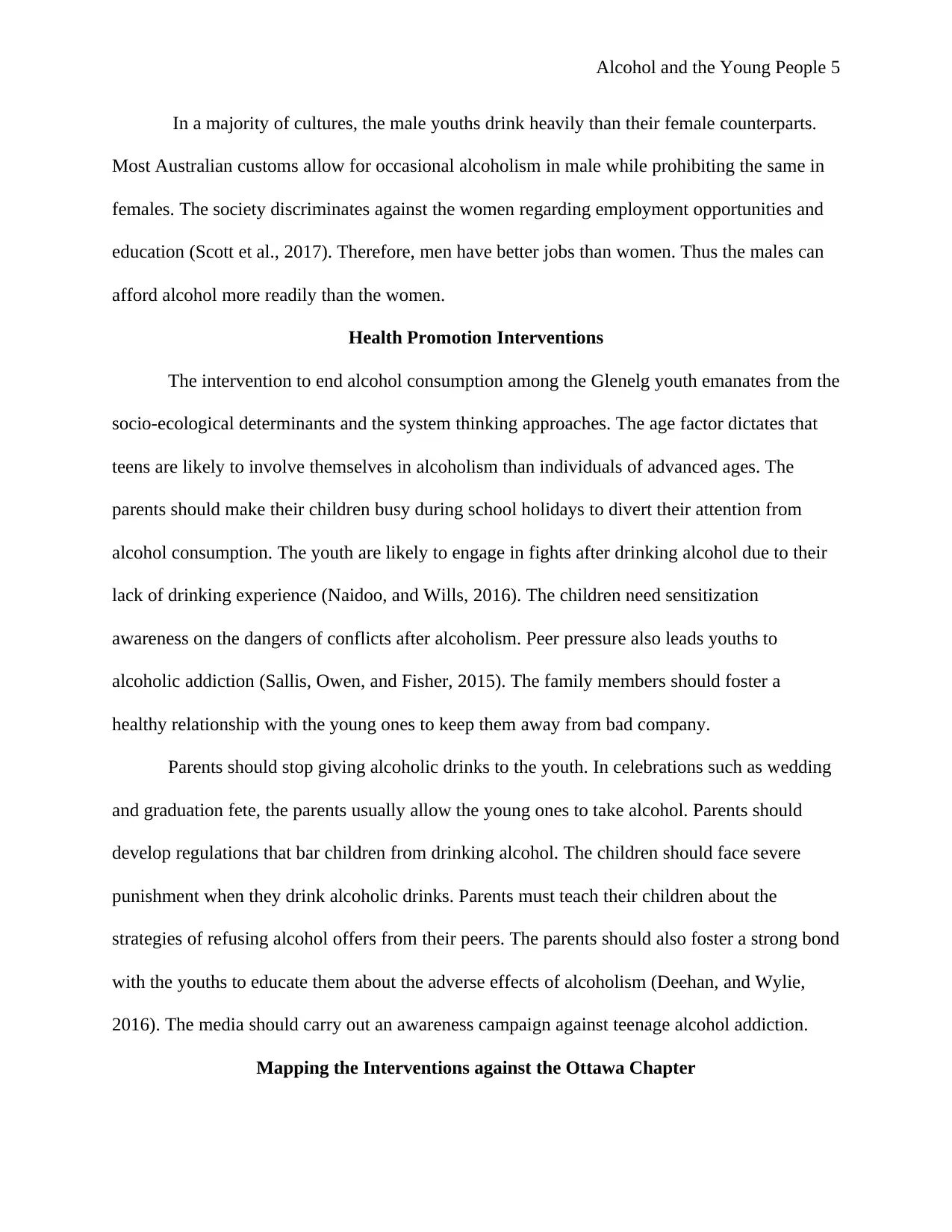
Alcohol and the Young People 5
In a majority of cultures, the male youths drink heavily than their female counterparts.
Most Australian customs allow for occasional alcoholism in male while prohibiting the same in
females. The society discriminates against the women regarding employment opportunities and
education (Scott et al., 2017). Therefore, men have better jobs than women. Thus the males can
afford alcohol more readily than the women.
Health Promotion Interventions
The intervention to end alcohol consumption among the Glenelg youth emanates from the
socio-ecological determinants and the system thinking approaches. The age factor dictates that
teens are likely to involve themselves in alcoholism than individuals of advanced ages. The
parents should make their children busy during school holidays to divert their attention from
alcohol consumption. The youth are likely to engage in fights after drinking alcohol due to their
lack of drinking experience (Naidoo, and Wills, 2016). The children need sensitization
awareness on the dangers of conflicts after alcoholism. Peer pressure also leads youths to
alcoholic addiction (Sallis, Owen, and Fisher, 2015). The family members should foster a
healthy relationship with the young ones to keep them away from bad company.
Parents should stop giving alcoholic drinks to the youth. In celebrations such as wedding
and graduation fete, the parents usually allow the young ones to take alcohol. Parents should
develop regulations that bar children from drinking alcohol. The children should face severe
punishment when they drink alcoholic drinks. Parents must teach their children about the
strategies of refusing alcohol offers from their peers. The parents should also foster a strong bond
with the youths to educate them about the adverse effects of alcoholism (Deehan, and Wylie,
2016). The media should carry out an awareness campaign against teenage alcohol addiction.
Mapping the Interventions against the Ottawa Chapter
In a majority of cultures, the male youths drink heavily than their female counterparts.
Most Australian customs allow for occasional alcoholism in male while prohibiting the same in
females. The society discriminates against the women regarding employment opportunities and
education (Scott et al., 2017). Therefore, men have better jobs than women. Thus the males can
afford alcohol more readily than the women.
Health Promotion Interventions
The intervention to end alcohol consumption among the Glenelg youth emanates from the
socio-ecological determinants and the system thinking approaches. The age factor dictates that
teens are likely to involve themselves in alcoholism than individuals of advanced ages. The
parents should make their children busy during school holidays to divert their attention from
alcohol consumption. The youth are likely to engage in fights after drinking alcohol due to their
lack of drinking experience (Naidoo, and Wills, 2016). The children need sensitization
awareness on the dangers of conflicts after alcoholism. Peer pressure also leads youths to
alcoholic addiction (Sallis, Owen, and Fisher, 2015). The family members should foster a
healthy relationship with the young ones to keep them away from bad company.
Parents should stop giving alcoholic drinks to the youth. In celebrations such as wedding
and graduation fete, the parents usually allow the young ones to take alcohol. Parents should
develop regulations that bar children from drinking alcohol. The children should face severe
punishment when they drink alcoholic drinks. Parents must teach their children about the
strategies of refusing alcohol offers from their peers. The parents should also foster a strong bond
with the youths to educate them about the adverse effects of alcoholism (Deehan, and Wylie,
2016). The media should carry out an awareness campaign against teenage alcohol addiction.
Mapping the Interventions against the Ottawa Chapter
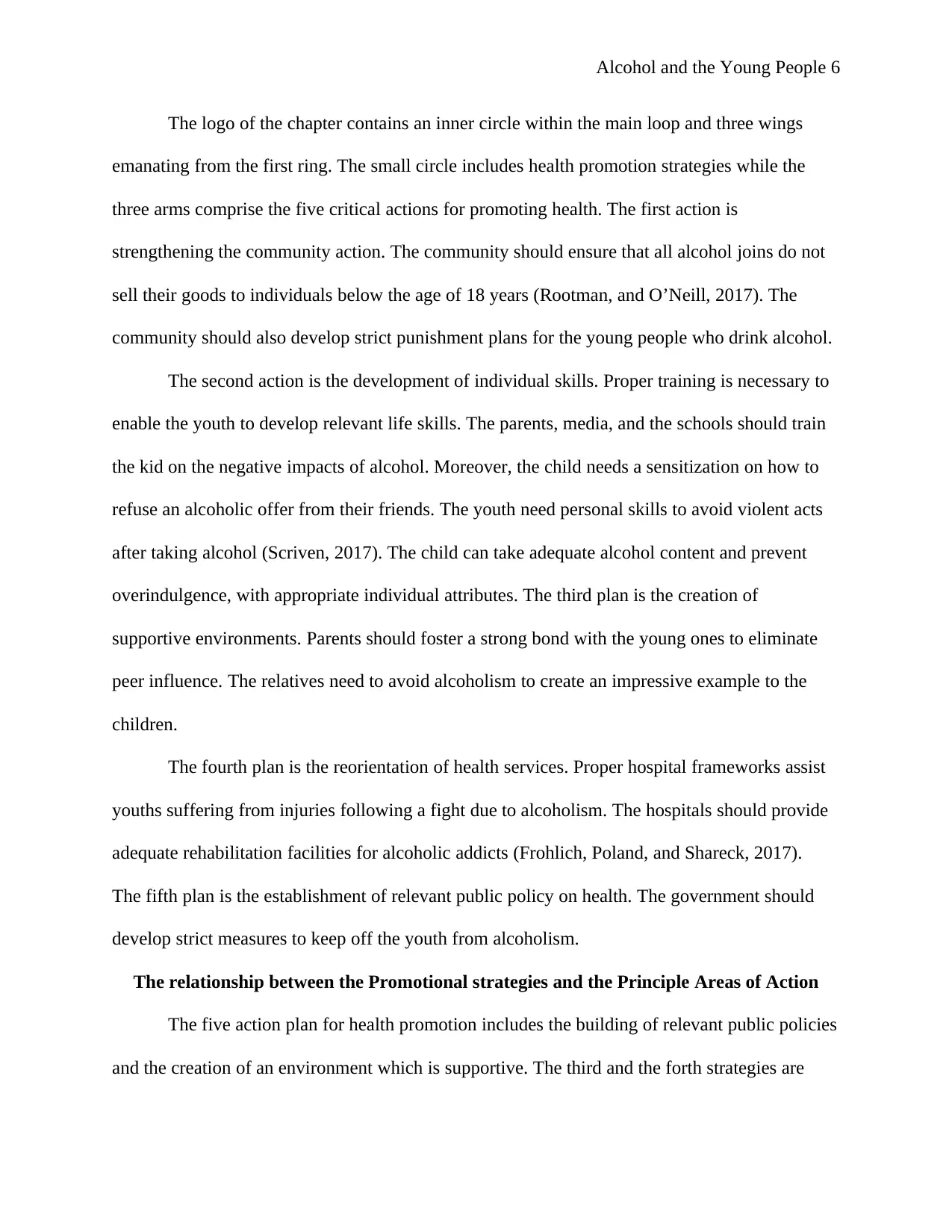
Alcohol and the Young People 6
The logo of the chapter contains an inner circle within the main loop and three wings
emanating from the first ring. The small circle includes health promotion strategies while the
three arms comprise the five critical actions for promoting health. The first action is
strengthening the community action. The community should ensure that all alcohol joins do not
sell their goods to individuals below the age of 18 years (Rootman, and O’Neill, 2017). The
community should also develop strict punishment plans for the young people who drink alcohol.
The second action is the development of individual skills. Proper training is necessary to
enable the youth to develop relevant life skills. The parents, media, and the schools should train
the kid on the negative impacts of alcohol. Moreover, the child needs a sensitization on how to
refuse an alcoholic offer from their friends. The youth need personal skills to avoid violent acts
after taking alcohol (Scriven, 2017). The child can take adequate alcohol content and prevent
overindulgence, with appropriate individual attributes. The third plan is the creation of
supportive environments. Parents should foster a strong bond with the young ones to eliminate
peer influence. The relatives need to avoid alcoholism to create an impressive example to the
children.
The fourth plan is the reorientation of health services. Proper hospital frameworks assist
youths suffering from injuries following a fight due to alcoholism. The hospitals should provide
adequate rehabilitation facilities for alcoholic addicts (Frohlich, Poland, and Shareck, 2017).
The fifth plan is the establishment of relevant public policy on health. The government should
develop strict measures to keep off the youth from alcoholism.
The relationship between the Promotional strategies and the Principle Areas of Action
The five action plan for health promotion includes the building of relevant public policies
and the creation of an environment which is supportive. The third and the forth strategies are
The logo of the chapter contains an inner circle within the main loop and three wings
emanating from the first ring. The small circle includes health promotion strategies while the
three arms comprise the five critical actions for promoting health. The first action is
strengthening the community action. The community should ensure that all alcohol joins do not
sell their goods to individuals below the age of 18 years (Rootman, and O’Neill, 2017). The
community should also develop strict punishment plans for the young people who drink alcohol.
The second action is the development of individual skills. Proper training is necessary to
enable the youth to develop relevant life skills. The parents, media, and the schools should train
the kid on the negative impacts of alcohol. Moreover, the child needs a sensitization on how to
refuse an alcoholic offer from their friends. The youth need personal skills to avoid violent acts
after taking alcohol (Scriven, 2017). The child can take adequate alcohol content and prevent
overindulgence, with appropriate individual attributes. The third plan is the creation of
supportive environments. Parents should foster a strong bond with the young ones to eliminate
peer influence. The relatives need to avoid alcoholism to create an impressive example to the
children.
The fourth plan is the reorientation of health services. Proper hospital frameworks assist
youths suffering from injuries following a fight due to alcoholism. The hospitals should provide
adequate rehabilitation facilities for alcoholic addicts (Frohlich, Poland, and Shareck, 2017).
The fifth plan is the establishment of relevant public policy on health. The government should
develop strict measures to keep off the youth from alcoholism.
The relationship between the Promotional strategies and the Principle Areas of Action
The five action plan for health promotion includes the building of relevant public policies
and the creation of an environment which is supportive. The third and the forth strategies are
⊘ This is a preview!⊘
Do you want full access?
Subscribe today to unlock all pages.

Trusted by 1+ million students worldwide
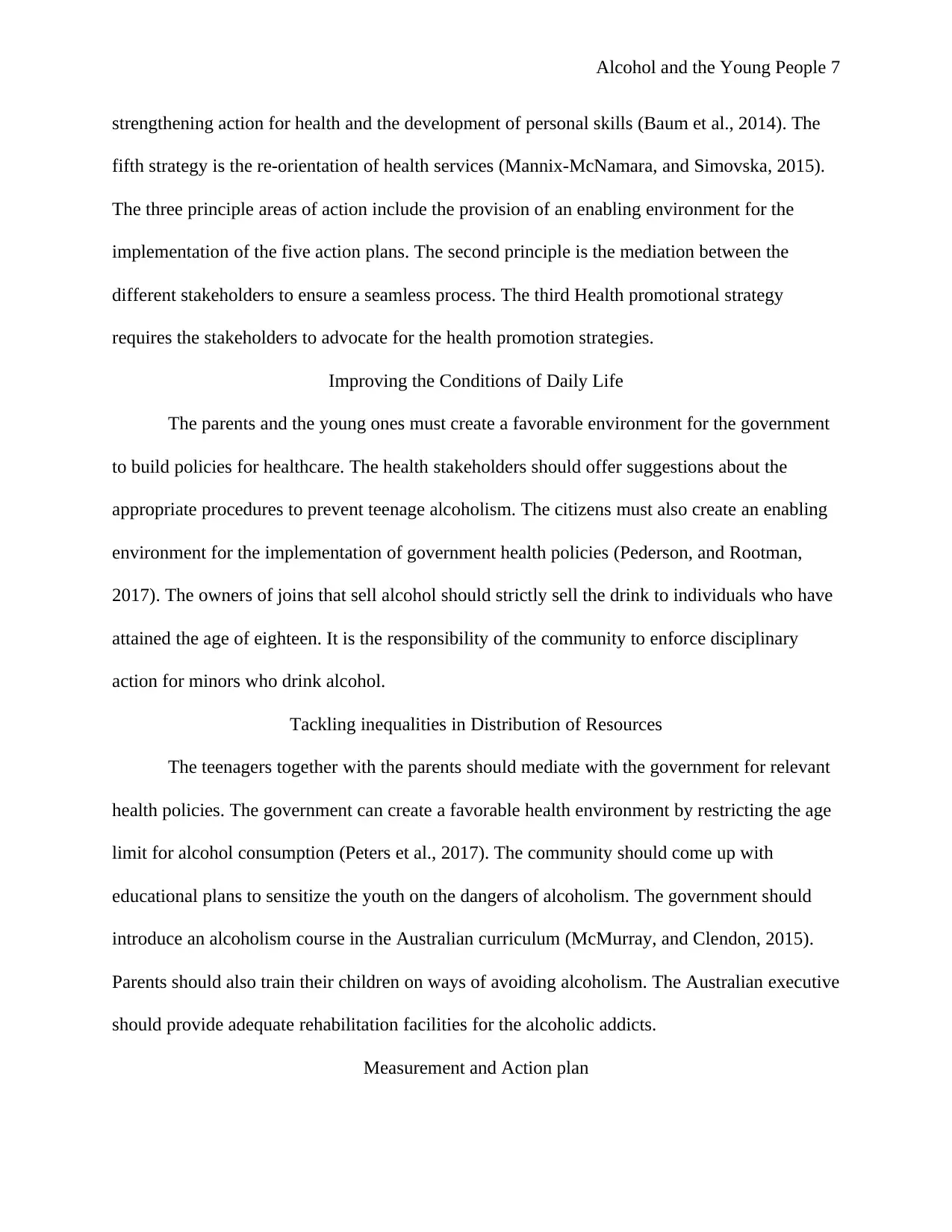
Alcohol and the Young People 7
strengthening action for health and the development of personal skills (Baum et al., 2014). The
fifth strategy is the re-orientation of health services (Mannix-McNamara, and Simovska, 2015).
The three principle areas of action include the provision of an enabling environment for the
implementation of the five action plans. The second principle is the mediation between the
different stakeholders to ensure a seamless process. The third Health promotional strategy
requires the stakeholders to advocate for the health promotion strategies.
Improving the Conditions of Daily Life
The parents and the young ones must create a favorable environment for the government
to build policies for healthcare. The health stakeholders should offer suggestions about the
appropriate procedures to prevent teenage alcoholism. The citizens must also create an enabling
environment for the implementation of government health policies (Pederson, and Rootman,
2017). The owners of joins that sell alcohol should strictly sell the drink to individuals who have
attained the age of eighteen. It is the responsibility of the community to enforce disciplinary
action for minors who drink alcohol.
Tackling inequalities in Distribution of Resources
The teenagers together with the parents should mediate with the government for relevant
health policies. The government can create a favorable health environment by restricting the age
limit for alcohol consumption (Peters et al., 2017). The community should come up with
educational plans to sensitize the youth on the dangers of alcoholism. The government should
introduce an alcoholism course in the Australian curriculum (McMurray, and Clendon, 2015).
Parents should also train their children on ways of avoiding alcoholism. The Australian executive
should provide adequate rehabilitation facilities for the alcoholic addicts.
Measurement and Action plan
strengthening action for health and the development of personal skills (Baum et al., 2014). The
fifth strategy is the re-orientation of health services (Mannix-McNamara, and Simovska, 2015).
The three principle areas of action include the provision of an enabling environment for the
implementation of the five action plans. The second principle is the mediation between the
different stakeholders to ensure a seamless process. The third Health promotional strategy
requires the stakeholders to advocate for the health promotion strategies.
Improving the Conditions of Daily Life
The parents and the young ones must create a favorable environment for the government
to build policies for healthcare. The health stakeholders should offer suggestions about the
appropriate procedures to prevent teenage alcoholism. The citizens must also create an enabling
environment for the implementation of government health policies (Pederson, and Rootman,
2017). The owners of joins that sell alcohol should strictly sell the drink to individuals who have
attained the age of eighteen. It is the responsibility of the community to enforce disciplinary
action for minors who drink alcohol.
Tackling inequalities in Distribution of Resources
The teenagers together with the parents should mediate with the government for relevant
health policies. The government can create a favorable health environment by restricting the age
limit for alcohol consumption (Peters et al., 2017). The community should come up with
educational plans to sensitize the youth on the dangers of alcoholism. The government should
introduce an alcoholism course in the Australian curriculum (McMurray, and Clendon, 2015).
Parents should also train their children on ways of avoiding alcoholism. The Australian executive
should provide adequate rehabilitation facilities for the alcoholic addicts.
Measurement and Action plan
Paraphrase This Document
Need a fresh take? Get an instant paraphrase of this document with our AI Paraphraser
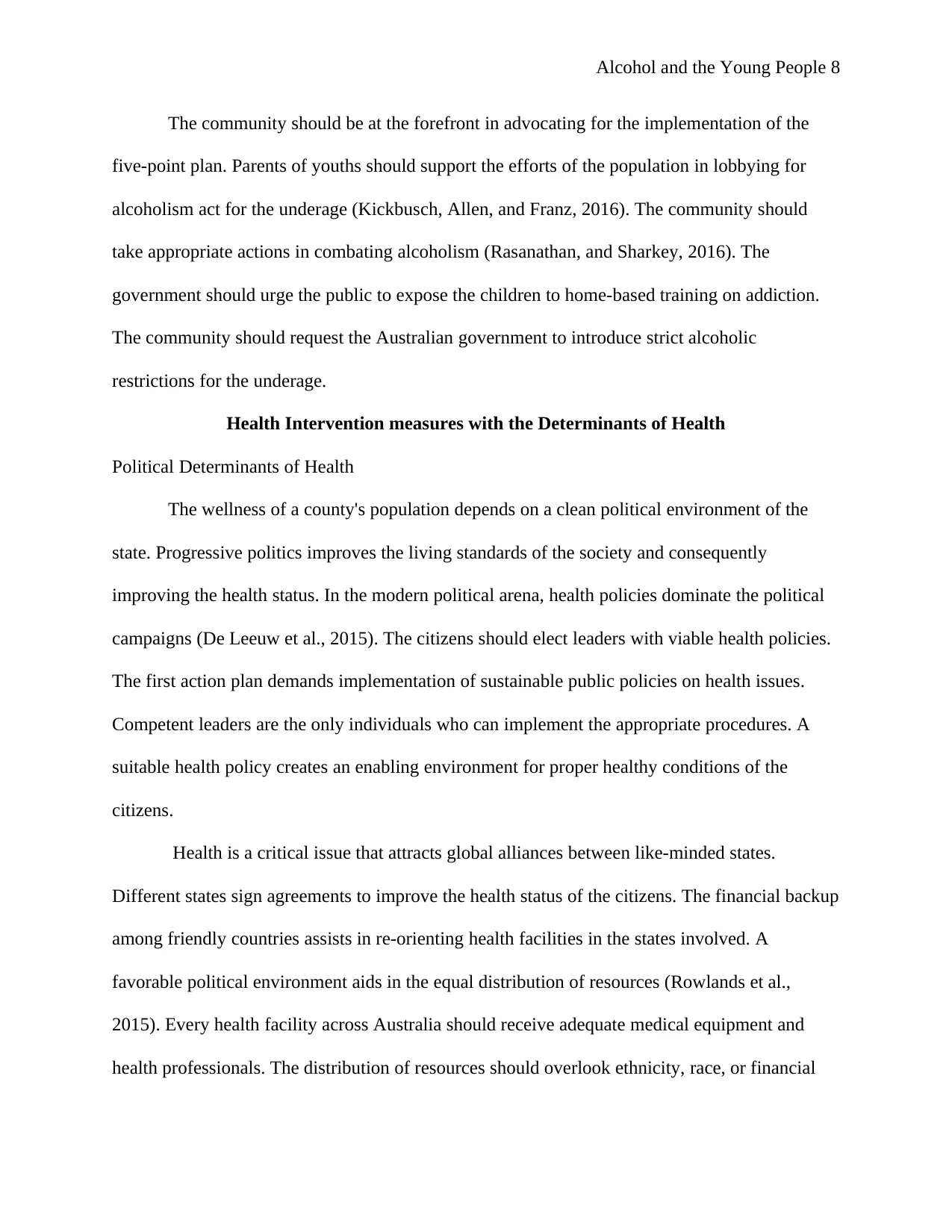
Alcohol and the Young People 8
The community should be at the forefront in advocating for the implementation of the
five-point plan. Parents of youths should support the efforts of the population in lobbying for
alcoholism act for the underage (Kickbusch, Allen, and Franz, 2016). The community should
take appropriate actions in combating alcoholism (Rasanathan, and Sharkey, 2016). The
government should urge the public to expose the children to home-based training on addiction.
The community should request the Australian government to introduce strict alcoholic
restrictions for the underage.
Health Intervention measures with the Determinants of Health
Political Determinants of Health
The wellness of a county's population depends on a clean political environment of the
state. Progressive politics improves the living standards of the society and consequently
improving the health status. In the modern political arena, health policies dominate the political
campaigns (De Leeuw et al., 2015). The citizens should elect leaders with viable health policies.
The first action plan demands implementation of sustainable public policies on health issues.
Competent leaders are the only individuals who can implement the appropriate procedures. A
suitable health policy creates an enabling environment for proper healthy conditions of the
citizens.
Health is a critical issue that attracts global alliances between like-minded states.
Different states sign agreements to improve the health status of the citizens. The financial backup
among friendly countries assists in re-orienting health facilities in the states involved. A
favorable political environment aids in the equal distribution of resources (Rowlands et al.,
2015). Every health facility across Australia should receive adequate medical equipment and
health professionals. The distribution of resources should overlook ethnicity, race, or financial
The community should be at the forefront in advocating for the implementation of the
five-point plan. Parents of youths should support the efforts of the population in lobbying for
alcoholism act for the underage (Kickbusch, Allen, and Franz, 2016). The community should
take appropriate actions in combating alcoholism (Rasanathan, and Sharkey, 2016). The
government should urge the public to expose the children to home-based training on addiction.
The community should request the Australian government to introduce strict alcoholic
restrictions for the underage.
Health Intervention measures with the Determinants of Health
Political Determinants of Health
The wellness of a county's population depends on a clean political environment of the
state. Progressive politics improves the living standards of the society and consequently
improving the health status. In the modern political arena, health policies dominate the political
campaigns (De Leeuw et al., 2015). The citizens should elect leaders with viable health policies.
The first action plan demands implementation of sustainable public policies on health issues.
Competent leaders are the only individuals who can implement the appropriate procedures. A
suitable health policy creates an enabling environment for proper healthy conditions of the
citizens.
Health is a critical issue that attracts global alliances between like-minded states.
Different states sign agreements to improve the health status of the citizens. The financial backup
among friendly countries assists in re-orienting health facilities in the states involved. A
favorable political environment aids in the equal distribution of resources (Rowlands et al.,
2015). Every health facility across Australia should receive adequate medical equipment and
health professionals. The distribution of resources should overlook ethnicity, race, or financial
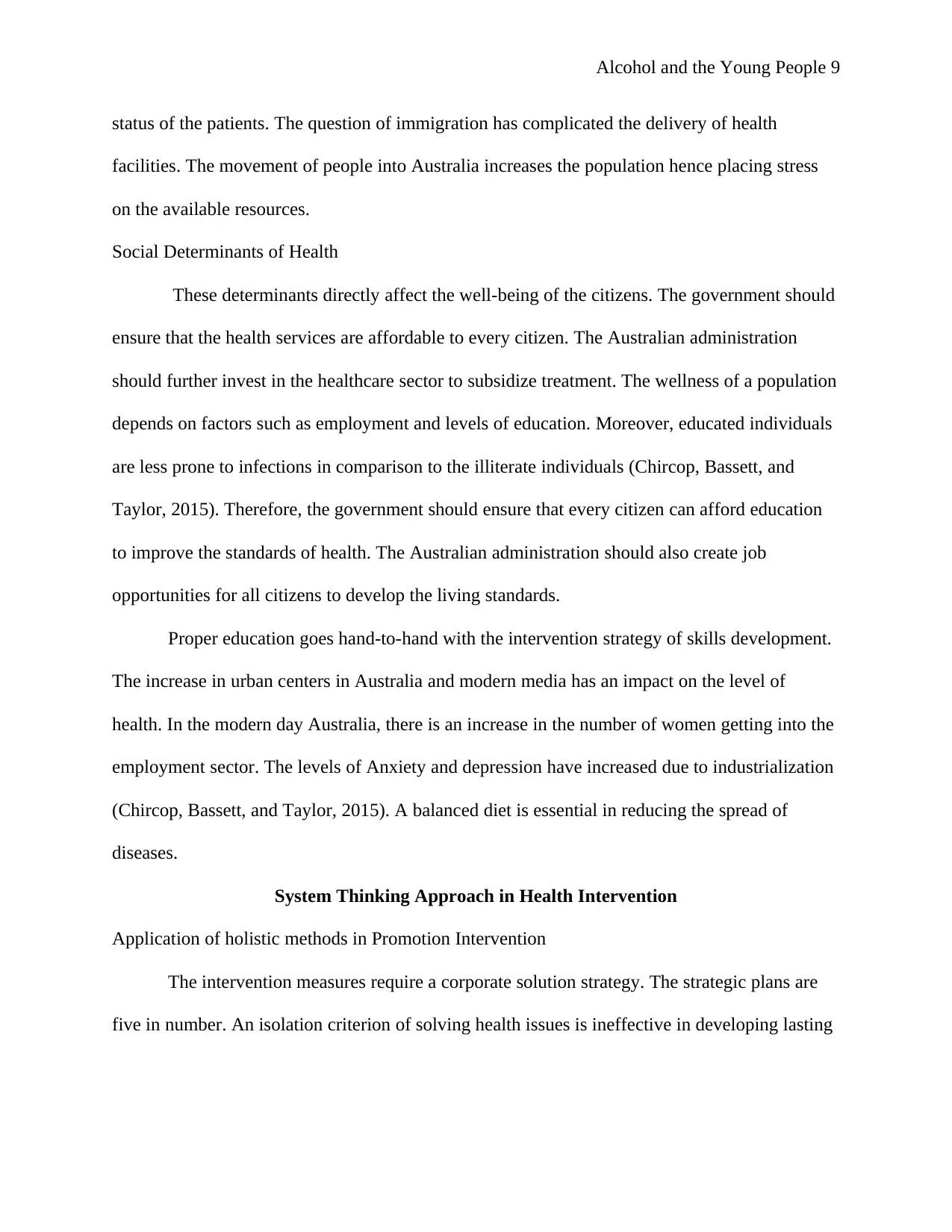
Alcohol and the Young People 9
status of the patients. The question of immigration has complicated the delivery of health
facilities. The movement of people into Australia increases the population hence placing stress
on the available resources.
Social Determinants of Health
These determinants directly affect the well-being of the citizens. The government should
ensure that the health services are affordable to every citizen. The Australian administration
should further invest in the healthcare sector to subsidize treatment. The wellness of a population
depends on factors such as employment and levels of education. Moreover, educated individuals
are less prone to infections in comparison to the illiterate individuals (Chircop, Bassett, and
Taylor, 2015). Therefore, the government should ensure that every citizen can afford education
to improve the standards of health. The Australian administration should also create job
opportunities for all citizens to develop the living standards.
Proper education goes hand-to-hand with the intervention strategy of skills development.
The increase in urban centers in Australia and modern media has an impact on the level of
health. In the modern day Australia, there is an increase in the number of women getting into the
employment sector. The levels of Anxiety and depression have increased due to industrialization
(Chircop, Bassett, and Taylor, 2015). A balanced diet is essential in reducing the spread of
diseases.
System Thinking Approach in Health Intervention
Application of holistic methods in Promotion Intervention
The intervention measures require a corporate solution strategy. The strategic plans are
five in number. An isolation criterion of solving health issues is ineffective in developing lasting
status of the patients. The question of immigration has complicated the delivery of health
facilities. The movement of people into Australia increases the population hence placing stress
on the available resources.
Social Determinants of Health
These determinants directly affect the well-being of the citizens. The government should
ensure that the health services are affordable to every citizen. The Australian administration
should further invest in the healthcare sector to subsidize treatment. The wellness of a population
depends on factors such as employment and levels of education. Moreover, educated individuals
are less prone to infections in comparison to the illiterate individuals (Chircop, Bassett, and
Taylor, 2015). Therefore, the government should ensure that every citizen can afford education
to improve the standards of health. The Australian administration should also create job
opportunities for all citizens to develop the living standards.
Proper education goes hand-to-hand with the intervention strategy of skills development.
The increase in urban centers in Australia and modern media has an impact on the level of
health. In the modern day Australia, there is an increase in the number of women getting into the
employment sector. The levels of Anxiety and depression have increased due to industrialization
(Chircop, Bassett, and Taylor, 2015). A balanced diet is essential in reducing the spread of
diseases.
System Thinking Approach in Health Intervention
Application of holistic methods in Promotion Intervention
The intervention measures require a corporate solution strategy. The strategic plans are
five in number. An isolation criterion of solving health issues is ineffective in developing lasting
⊘ This is a preview!⊘
Do you want full access?
Subscribe today to unlock all pages.

Trusted by 1+ million students worldwide
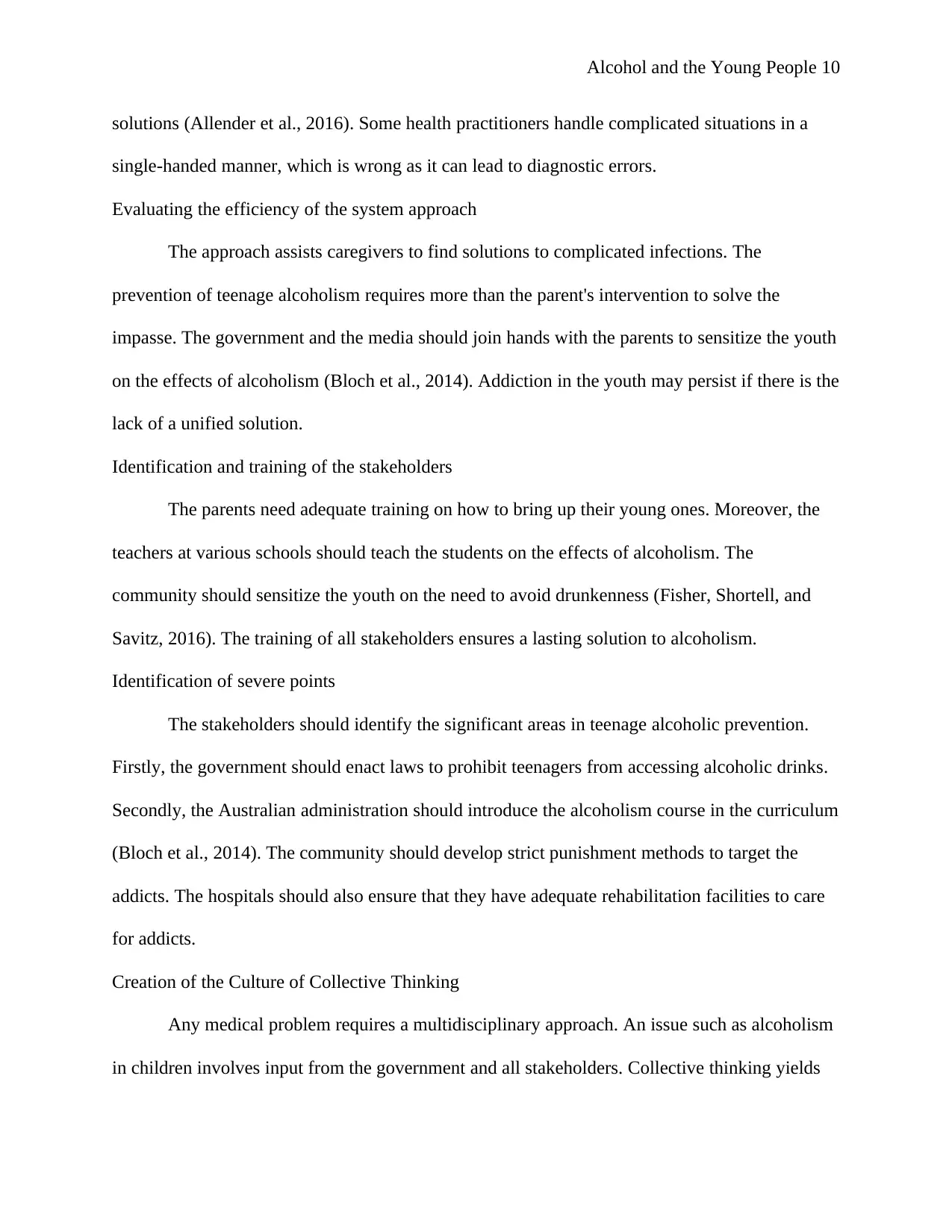
Alcohol and the Young People 10
solutions (Allender et al., 2016). Some health practitioners handle complicated situations in a
single-handed manner, which is wrong as it can lead to diagnostic errors.
Evaluating the efficiency of the system approach
The approach assists caregivers to find solutions to complicated infections. The
prevention of teenage alcoholism requires more than the parent's intervention to solve the
impasse. The government and the media should join hands with the parents to sensitize the youth
on the effects of alcoholism (Bloch et al., 2014). Addiction in the youth may persist if there is the
lack of a unified solution.
Identification and training of the stakeholders
The parents need adequate training on how to bring up their young ones. Moreover, the
teachers at various schools should teach the students on the effects of alcoholism. The
community should sensitize the youth on the need to avoid drunkenness (Fisher, Shortell, and
Savitz, 2016). The training of all stakeholders ensures a lasting solution to alcoholism.
Identification of severe points
The stakeholders should identify the significant areas in teenage alcoholic prevention.
Firstly, the government should enact laws to prohibit teenagers from accessing alcoholic drinks.
Secondly, the Australian administration should introduce the alcoholism course in the curriculum
(Bloch et al., 2014). The community should develop strict punishment methods to target the
addicts. The hospitals should also ensure that they have adequate rehabilitation facilities to care
for addicts.
Creation of the Culture of Collective Thinking
Any medical problem requires a multidisciplinary approach. An issue such as alcoholism
in children involves input from the government and all stakeholders. Collective thinking yields
solutions (Allender et al., 2016). Some health practitioners handle complicated situations in a
single-handed manner, which is wrong as it can lead to diagnostic errors.
Evaluating the efficiency of the system approach
The approach assists caregivers to find solutions to complicated infections. The
prevention of teenage alcoholism requires more than the parent's intervention to solve the
impasse. The government and the media should join hands with the parents to sensitize the youth
on the effects of alcoholism (Bloch et al., 2014). Addiction in the youth may persist if there is the
lack of a unified solution.
Identification and training of the stakeholders
The parents need adequate training on how to bring up their young ones. Moreover, the
teachers at various schools should teach the students on the effects of alcoholism. The
community should sensitize the youth on the need to avoid drunkenness (Fisher, Shortell, and
Savitz, 2016). The training of all stakeholders ensures a lasting solution to alcoholism.
Identification of severe points
The stakeholders should identify the significant areas in teenage alcoholic prevention.
Firstly, the government should enact laws to prohibit teenagers from accessing alcoholic drinks.
Secondly, the Australian administration should introduce the alcoholism course in the curriculum
(Bloch et al., 2014). The community should develop strict punishment methods to target the
addicts. The hospitals should also ensure that they have adequate rehabilitation facilities to care
for addicts.
Creation of the Culture of Collective Thinking
Any medical problem requires a multidisciplinary approach. An issue such as alcoholism
in children involves input from the government and all stakeholders. Collective thinking yields
Paraphrase This Document
Need a fresh take? Get an instant paraphrase of this document with our AI Paraphraser
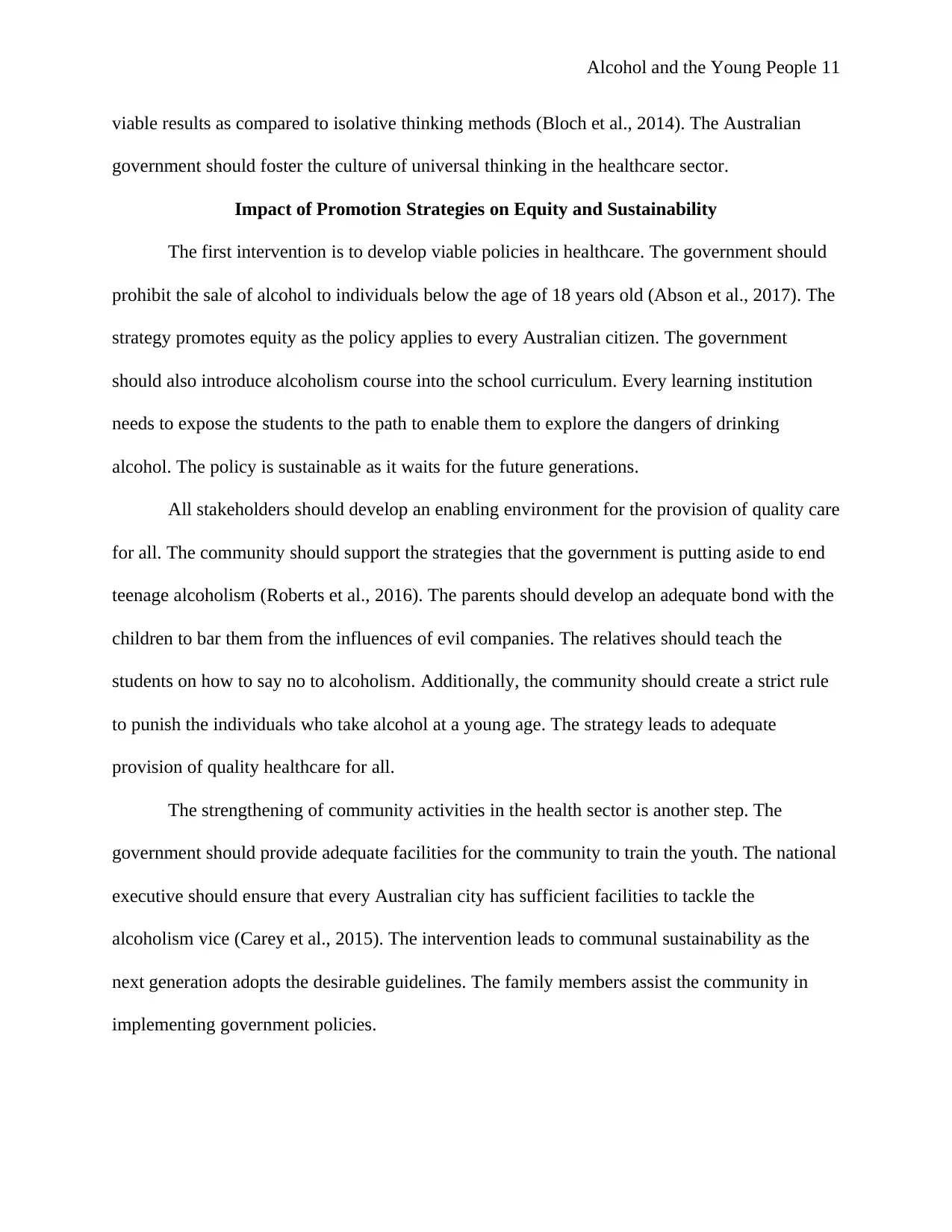
Alcohol and the Young People 11
viable results as compared to isolative thinking methods (Bloch et al., 2014). The Australian
government should foster the culture of universal thinking in the healthcare sector.
Impact of Promotion Strategies on Equity and Sustainability
The first intervention is to develop viable policies in healthcare. The government should
prohibit the sale of alcohol to individuals below the age of 18 years old (Abson et al., 2017). The
strategy promotes equity as the policy applies to every Australian citizen. The government
should also introduce alcoholism course into the school curriculum. Every learning institution
needs to expose the students to the path to enable them to explore the dangers of drinking
alcohol. The policy is sustainable as it waits for the future generations.
All stakeholders should develop an enabling environment for the provision of quality care
for all. The community should support the strategies that the government is putting aside to end
teenage alcoholism (Roberts et al., 2016). The parents should develop an adequate bond with the
children to bar them from the influences of evil companies. The relatives should teach the
students on how to say no to alcoholism. Additionally, the community should create a strict rule
to punish the individuals who take alcohol at a young age. The strategy leads to adequate
provision of quality healthcare for all.
The strengthening of community activities in the health sector is another step. The
government should provide adequate facilities for the community to train the youth. The national
executive should ensure that every Australian city has sufficient facilities to tackle the
alcoholism vice (Carey et al., 2015). The intervention leads to communal sustainability as the
next generation adopts the desirable guidelines. The family members assist the community in
implementing government policies.
viable results as compared to isolative thinking methods (Bloch et al., 2014). The Australian
government should foster the culture of universal thinking in the healthcare sector.
Impact of Promotion Strategies on Equity and Sustainability
The first intervention is to develop viable policies in healthcare. The government should
prohibit the sale of alcohol to individuals below the age of 18 years old (Abson et al., 2017). The
strategy promotes equity as the policy applies to every Australian citizen. The government
should also introduce alcoholism course into the school curriculum. Every learning institution
needs to expose the students to the path to enable them to explore the dangers of drinking
alcohol. The policy is sustainable as it waits for the future generations.
All stakeholders should develop an enabling environment for the provision of quality care
for all. The community should support the strategies that the government is putting aside to end
teenage alcoholism (Roberts et al., 2016). The parents should develop an adequate bond with the
children to bar them from the influences of evil companies. The relatives should teach the
students on how to say no to alcoholism. Additionally, the community should create a strict rule
to punish the individuals who take alcohol at a young age. The strategy leads to adequate
provision of quality healthcare for all.
The strengthening of community activities in the health sector is another step. The
government should provide adequate facilities for the community to train the youth. The national
executive should ensure that every Australian city has sufficient facilities to tackle the
alcoholism vice (Carey et al., 2015). The intervention leads to communal sustainability as the
next generation adopts the desirable guidelines. The family members assist the community in
implementing government policies.
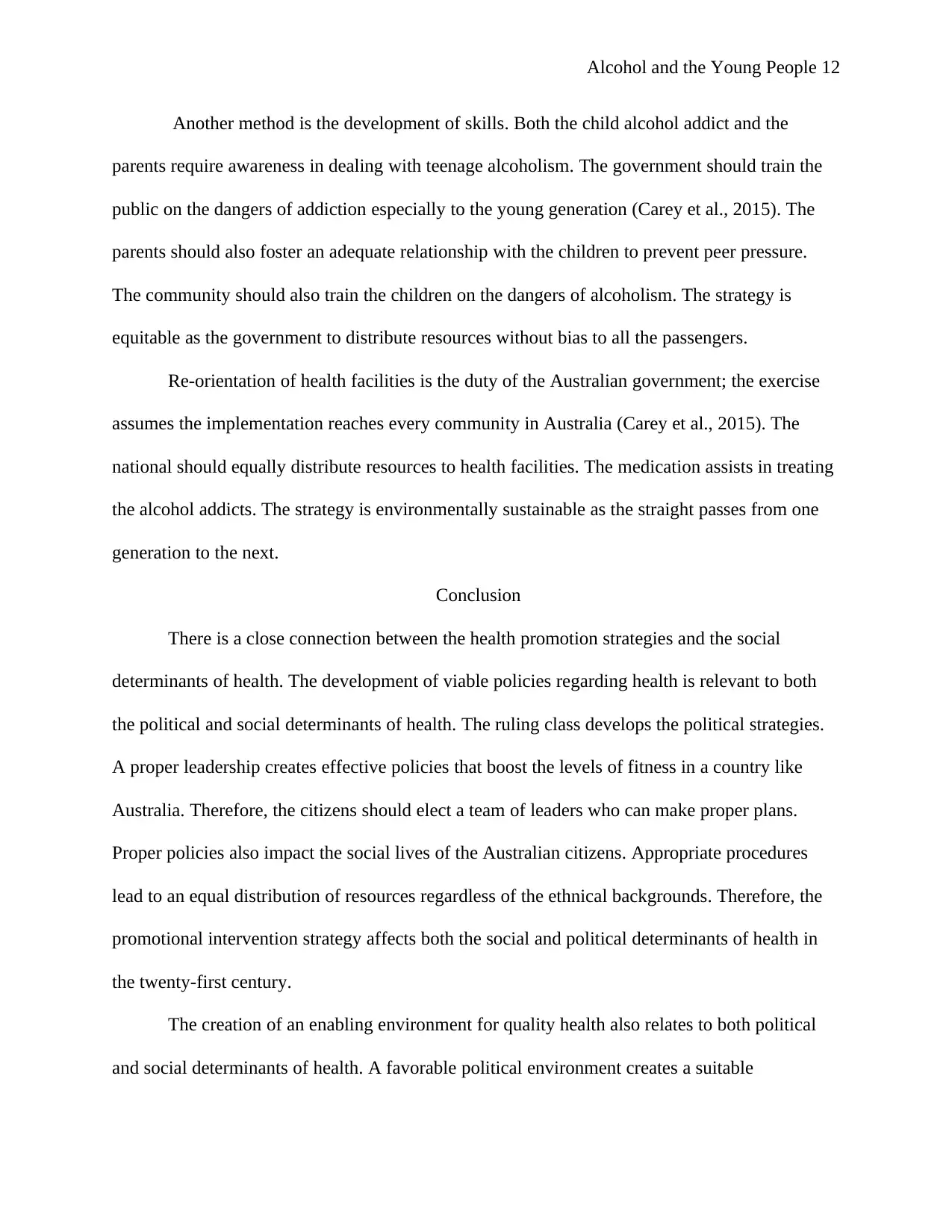
Alcohol and the Young People 12
Another method is the development of skills. Both the child alcohol addict and the
parents require awareness in dealing with teenage alcoholism. The government should train the
public on the dangers of addiction especially to the young generation (Carey et al., 2015). The
parents should also foster an adequate relationship with the children to prevent peer pressure.
The community should also train the children on the dangers of alcoholism. The strategy is
equitable as the government to distribute resources without bias to all the passengers.
Re-orientation of health facilities is the duty of the Australian government; the exercise
assumes the implementation reaches every community in Australia (Carey et al., 2015). The
national should equally distribute resources to health facilities. The medication assists in treating
the alcohol addicts. The strategy is environmentally sustainable as the straight passes from one
generation to the next.
Conclusion
There is a close connection between the health promotion strategies and the social
determinants of health. The development of viable policies regarding health is relevant to both
the political and social determinants of health. The ruling class develops the political strategies.
A proper leadership creates effective policies that boost the levels of fitness in a country like
Australia. Therefore, the citizens should elect a team of leaders who can make proper plans.
Proper policies also impact the social lives of the Australian citizens. Appropriate procedures
lead to an equal distribution of resources regardless of the ethnical backgrounds. Therefore, the
promotional intervention strategy affects both the social and political determinants of health in
the twenty-first century.
The creation of an enabling environment for quality health also relates to both political
and social determinants of health. A favorable political environment creates a suitable
Another method is the development of skills. Both the child alcohol addict and the
parents require awareness in dealing with teenage alcoholism. The government should train the
public on the dangers of addiction especially to the young generation (Carey et al., 2015). The
parents should also foster an adequate relationship with the children to prevent peer pressure.
The community should also train the children on the dangers of alcoholism. The strategy is
equitable as the government to distribute resources without bias to all the passengers.
Re-orientation of health facilities is the duty of the Australian government; the exercise
assumes the implementation reaches every community in Australia (Carey et al., 2015). The
national should equally distribute resources to health facilities. The medication assists in treating
the alcohol addicts. The strategy is environmentally sustainable as the straight passes from one
generation to the next.
Conclusion
There is a close connection between the health promotion strategies and the social
determinants of health. The development of viable policies regarding health is relevant to both
the political and social determinants of health. The ruling class develops the political strategies.
A proper leadership creates effective policies that boost the levels of fitness in a country like
Australia. Therefore, the citizens should elect a team of leaders who can make proper plans.
Proper policies also impact the social lives of the Australian citizens. Appropriate procedures
lead to an equal distribution of resources regardless of the ethnical backgrounds. Therefore, the
promotional intervention strategy affects both the social and political determinants of health in
the twenty-first century.
The creation of an enabling environment for quality health also relates to both political
and social determinants of health. A favorable political environment creates a suitable
⊘ This is a preview!⊘
Do you want full access?
Subscribe today to unlock all pages.

Trusted by 1+ million students worldwide
1 out of 18
Related Documents
Your All-in-One AI-Powered Toolkit for Academic Success.
+13062052269
info@desklib.com
Available 24*7 on WhatsApp / Email
![[object Object]](/_next/static/media/star-bottom.7253800d.svg)
Unlock your academic potential
Copyright © 2020–2025 A2Z Services. All Rights Reserved. Developed and managed by ZUCOL.





